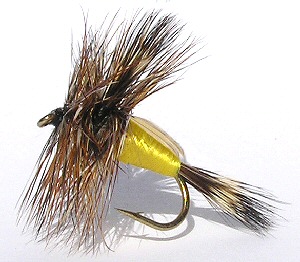Yellow Humpy Dry Fly
The North American Humpy fly pattern is mainly a fast water attractor with very good floatability and visibility. The origin of the Humpy pattern is in dispute. Some say it is a combination of Jack Horner’s Deer Hair pattern and Canada’s Tom Thumb. Both patterns were in use on Western North American streams in the late 1930’s.

HUMPY DRY FLY PATTERNS. Hook size 12 14 16 - $US each
In his article "Goofus Bug Evolution" in the American Angler (Spring, 1990) Pat Barnes credits this pattern to Keith Kenyon. Kenyon, a Montana guide and tier, created in 1944 for the Firehole River. Its effectiveness leaked out and requests for that "goofy deer hair fly" bombarded Pat and Sig in their West Yellowstone shop. Thus the name "Goofus Bug" was adopted. The name "Humpy" applies to this pattern coming from Wyoming sources. Others credit Leonard ‘Boots’ Allen as the designer. He was tying and selling Humpies in the late 1940’s. Over the years other tiers have made small changes. In the 1960’s Jack Dennis experimented with different types of hair to increase the Humpy’s durability. As an attractor pattern it is amazing how well it works even when there is no hatch on. Just like the buoyant bushy Wulff patterns they work particularly well on rough water as well as on calmer water.
The Humpy dry fly presents a bushy, high floating fly, that remains visible into the evening twilight, and rides well in rough water. Every modern fly angler should have one or more humpy or Wulff dry fly for rough water, windy or twilight situation's. The traditional British feather wing fly was too delicate for some North American water. The solution was to use bucktail (deerhair) for tails and wings. The mobility and buoyancy of elk and deer hair has made it a favorite North American fly tying material. When you first use Humpy flies treat with floatant and fish on the surface. Leave the fly to drift with the current. Occasionally accelerate it gently over short distances of a yard (meter) or more, or else twitch it to represent a struggling insect trapped in the surface film.
On days when a cold wind ruffles the water surface, when the river or stream is swollen from over night rains, that is the time to go for a big fly. There is little likelihood of a hatch. Most anglers turn to their trusted nymph patterns. Brake with the norm. Look for pockets and pools of calmer water where the trout will take refuge from the fierce current. Work upstream and fish a big fly into this gathering place. Let the fly drift for a little way and then give it a gentle tweak to create a tiny wake on the water surface to suggest life. I find it is best to check the flies progress with the rod tip rather than pulling in the fly line to prevent line drag showing up un-naturally on the surface and spooking the fish. Look for that small patch of calmer water directly behind larger rocks or the quieter area found between two meeting currents. I have found it best not to cast to the same area too often. A couple of casts to one then move on to the next and then the next, then return to the first area
It is the large imprint on the water's surface that attracts the trout's attention. they are opportunists by nature and normally will not pass up such a substantial meal so long as it is cast and present correctly. As an experiment I cast one of these large flies during a hatch of tiny flies. The tiny fly designs in my fly box were the wrong color and not working. The fish were pre-occupied with supping down the surface feast. Casts that were not in front of the fish's nose were ignored, but get your large fly within it's forward target zone and whoosh, it would be taken in a greedy attack. Because of the more extravagant hackles on these flies their aerodynamic qualities are not very good. Delicate presentations are difficult. I find slowing down on the cast helps and I use a stronger leader of about 5lb breaking strain. Do not even think of using fine tippets as you will end in an annoying tangled mess. In really windy weather I even use a heavier leader.
THE YELLOW HUMPY AND THE SCOTTISH HIGHLANDS
I was fishing a pool on the River Oude in the Scottish Highlands. The local river keeper down the pub the evening before had recommended I try a yellow humpy on a size 14 hook with the words, "If you want big fish laddie, you have to use a big fly."
Fishing directly across the pool, I took larger and larger brown trout, culminating in what I felt was a near monster by the standards of this stretch of the river Oude, of being just over 12 inches in length. It was remarkably chubby for a small trout in an acidic river. I was amazed at the fight it put up. I had become used to the sullen dull reactions of the 1-2 lb stocked browns in many southern waters. A hardy muscular wild northern fish of ½ to ¾ lb is an exciting handful on light fishing tackle in a small river.
FACEBOOK READER'S COMMENT
Caught my first brown trout on the Cowichan River (Vancouver Island) using a yellow Humpy in the mid-1960's. Wulff dries were also very popular at that time as was the Brown Bi-visible.
- By Frank Dalziel
LINKEDIN READER'S COMMENTS
I use both humpy and wullf flies in NZ on different waters. On the Rangitikei river for example I only use the humpy or adams during the summer months - By Doug Stevens
Fly Fishing books



